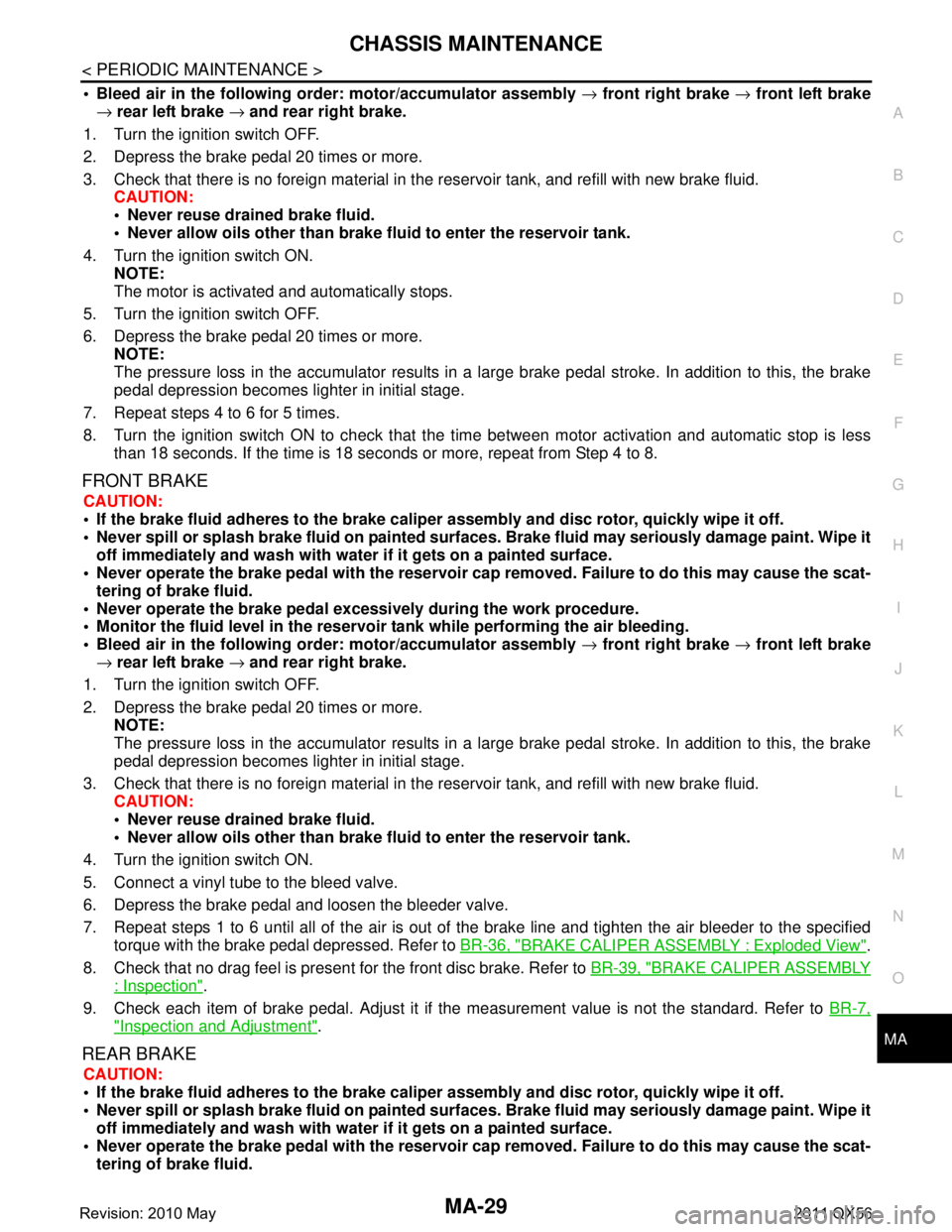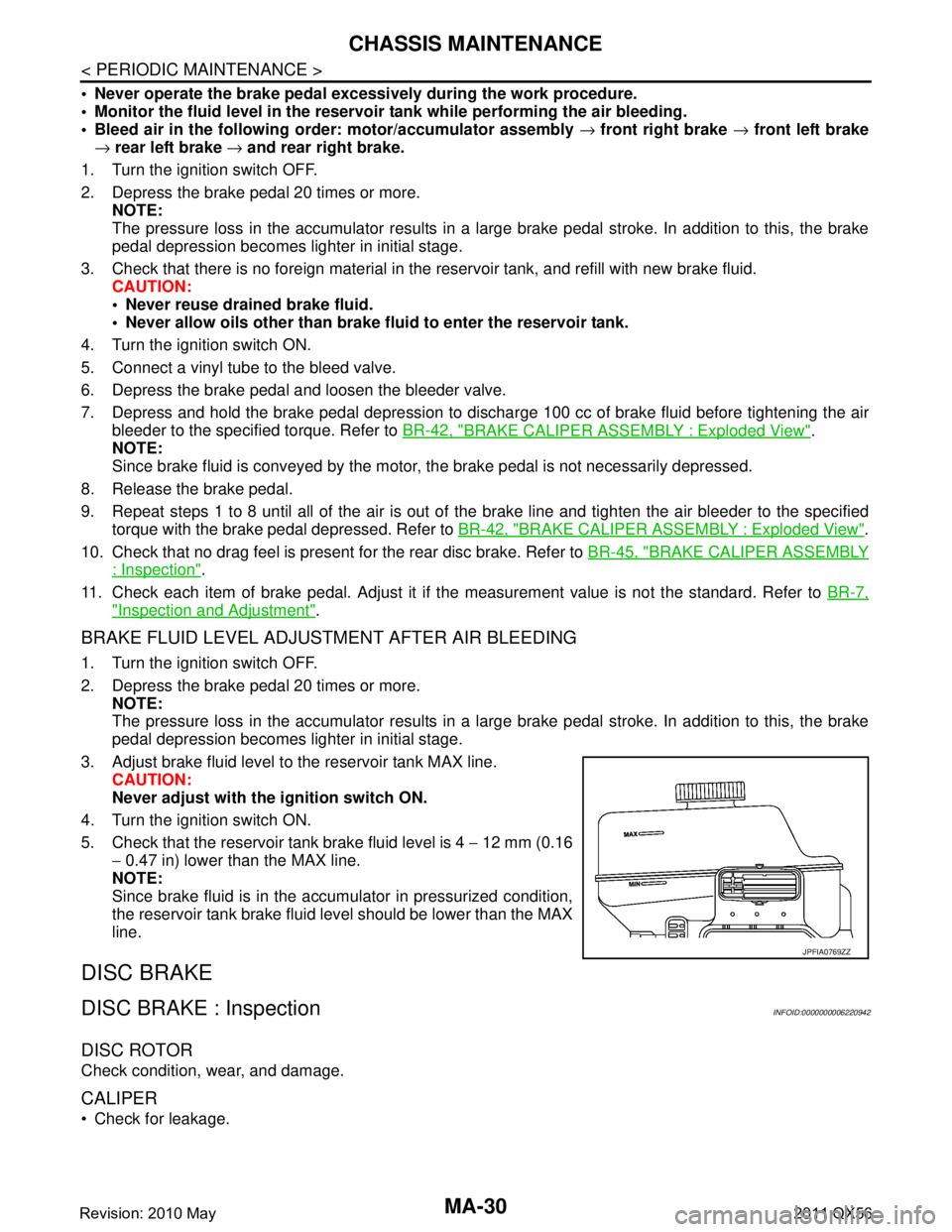2011 INFINITI QX56 brake light
[x] Cancel search: brake lightPage 2528 of 5598
![INFINITI QX56 2011 Factory Service Manual
EC-504
< DTC/CIRCUIT DIAGNOSIS >[VK56VD]
ICC BRAKE SWITCH
Is the inspection result normal?
YES >> INSPECTION END
NO >> GO TO 3.
3.CHECK ICC BRAKE SWITCH POWER SUPPLY CIRCUIT-I
1. Turn ignition switch INFINITI QX56 2011 Factory Service Manual
EC-504
< DTC/CIRCUIT DIAGNOSIS >[VK56VD]
ICC BRAKE SWITCH
Is the inspection result normal?
YES >> INSPECTION END
NO >> GO TO 3.
3.CHECK ICC BRAKE SWITCH POWER SUPPLY CIRCUIT-I
1. Turn ignition switch](/manual-img/42/57033/w960_57033-2527.png)
EC-504
< DTC/CIRCUIT DIAGNOSIS >[VK56VD]
ICC BRAKE SWITCH
Is the inspection result normal?
YES >> INSPECTION END
NO >> GO TO 3.
3.CHECK ICC BRAKE SWITCH POWER SUPPLY CIRCUIT-I
1. Turn ignition switch OFF.
2. Disconnect ICC brake switch harness connector.
3. Turn ignition switch ON.
4. Check the voltage between ICC brake switch harness connector and ground.
Is the inspection result normal?
YES >> GO TO 7.
NO >> GO TO 4.
4.CHECK ICC BRAKE SWITCH POWER SUPPLY CIRCUIT-II
Check the voltage between ICC brake switch harness connector and ground.
Is the inspection result normal?
YES >> GO TO 6.
NO >> GO TO 5.
5.DETECT MALFUNCTIONING PART
Check the following.
Fuse block (J/B) connector E103
10 A fuse (No. 3)
Harness for open or short between ICC brake switch and fuse
>> Repair open circuit or short to ground in harness or connectors.
6.CHECK ICC BRAKE SWITCH
Refer to EC-445, "
Component Inspection (ICC Brake Switch)".
Is the inspection result normal?
YES >> GO TO 9.
NO >> Replace ICC brake switch. Refer to BR-20, "
Removal and Installation".
7.CHECK ICC BRAKE SWITCH INPUT SIGNAL CIRCUIT FOR OPEN AND SHORT
1. Turn ignition switch OFF.
2. Disconnect ECM harness connector.
3. Check the continuity between ICC brake s witch harness connector and ECM harness connector.
ECM
Condition Voltage (V)
Connector +–
Te r m i n a l Te r m i n a l
E80 147
(ICC brake switch signal) 175 Brake pedalSlightly depressed Approx. 0
Fully released Battery voltage
ICC brake switch
Ground Voltage
Connector Terminal
E68 2 Ground Battery voltage
ICC brake switch Ground Voltage
Connector Terminal
E68 1 Ground Battery voltage
Revision: 2010 May2011 QX56
Page 2529 of 5598
![INFINITI QX56 2011 Factory Service Manual
ICC BRAKE SWITCHEC-505
< DTC/CIRCUIT DIAGNOSIS > [VK56VD]
C
D
E
F
G H
I
J
K L
M A
EC
NP
O
4. Also check harness for short to ground and short to power.
Is the inspection result normal?
YES >> GO TO 9 INFINITI QX56 2011 Factory Service Manual
ICC BRAKE SWITCHEC-505
< DTC/CIRCUIT DIAGNOSIS > [VK56VD]
C
D
E
F
G H
I
J
K L
M A
EC
NP
O
4. Also check harness for short to ground and short to power.
Is the inspection result normal?
YES >> GO TO 9](/manual-img/42/57033/w960_57033-2528.png)
ICC BRAKE SWITCHEC-505
< DTC/CIRCUIT DIAGNOSIS > [VK56VD]
C
D
E
F
G H
I
J
K L
M A
EC
NP
O
4. Also check harness for short to ground and short to power.
Is the inspection result normal?
YES >> GO TO 9.
NO >> GO TO 8.
8.DETECT MALFUNCTIONING PART
Check the following.
Harness for open or short between ICC brake switch and ECM
Loose or poor connection for each connector and harness
>> Repair open circuit, short to ground or short to power in harness or connectors.
9.CHECK INTERMITTENT INCIDENT
Refer to GI-40, "
Intermittent Incident".
>> INSPECTION END
Component Inspection (ICC Brake Switch)INFOID:0000000006218010
1.CHECK ICC BRAKE SWITCH-I
1. Turn ignition switch OFF.
2. Disconnect ICC brake switch harness connector.
3. Check the continuity between ICC brake switch terminals under the following conditions.
Is the inspection result normal?
YES >> INSPECTION END
NO >> GO TO 2.
2.CHECK ICC BRAKE SWITCH-II
1. Adjust ICC brake switch installation. Refer to BR-21, "
Inspection and Adjustment".
2. Check the continuity between ICC brake switch terminals under the following conditions.
Is the inspection result normal?
YES >> INSPECTION END
NO >> Replace ICC brake switch. Refer to BR-20, "
Removal and Installation".
ICC brake switch ECM
Continuity
Connector Terminal Connector Terminal
E68 2 E80 147 Existed
Terminals Condition Continuity
1 and 2 Brake pedal Fully released Existed
Slightly depressed Not existed
Terminals Condition Continuity
1 and 2 Brake pedal Fully released Existed
Slightly depressed Not existed
Revision: 2010 May2011 QX56
Page 2724 of 5598
![INFINITI QX56 2011 Factory Service Manual
EXL-14
< SYSTEM DESCRIPTION >[XENON TYPE]
SYSTEM
AUTO LIGHT ADJUSTMENT SYSTEM
The auto light adjustment system automatically, dims/bri
ghtens the display and combination meter, according
to brightnes INFINITI QX56 2011 Factory Service Manual
EXL-14
< SYSTEM DESCRIPTION >[XENON TYPE]
SYSTEM
AUTO LIGHT ADJUSTMENT SYSTEM
The auto light adjustment system automatically, dims/bri
ghtens the display and combination meter, according
to brightnes](/manual-img/42/57033/w960_57033-2723.png)
EXL-14
< SYSTEM DESCRIPTION >[XENON TYPE]
SYSTEM
AUTO LIGHT ADJUSTMENT SYSTEM
The auto light adjustment system automatically, dims/bri
ghtens the display and combination meter, according
to brightness outside the vehicle, when lighting switch 1ST or lighting switch 2ND is operated. Refer to INL-11,
"AUTO LIGHT ADJUSTMENT SYSTEM : System Description".
DELAY TIMER FUNCTION
BCM turns the exterior lamp OFF depending on the vehicle condition with the auto light function when the igni-
tion switch is turned OFF.
Turns the exterior lamp OFF 5 minutes afte r detecting that any door opens. (Door switch ON).
Turns the exterior lamp OFF a certain period of time* after closing all doors. (Door switch ON →OFF).
Turns the exterior lamp OFF with the igni tion switch ACC or the light switch OFF.
*: The preset time is 45 seconds. The timer operat ing time can be set by CONSULT-III. Refer to EXL-23,
"HEADLAMP : CONSULT-III Function (BCM - HEAD LAMP)".
NOTE:
When any position other than the light switch AUTO is set, the auto light system function switches to the exte-
rior lamp battery saver function.
DAYTIME RUNNING LIGHT SYSTEM
DAYTIME RUNNING LIGHT S YSTEM : System DiagramINFOID:0000000006214028
DAYTIME RUNNING LIGHT SYSTEM : System DescriptionINFOID:0000000006214029
OUTLINE
Turns the front fog lamp ON as the daytime running light.
Daytime running light is controlled by daytime runni ng light control function and combination switch reading
function of BCM, and relay c ontrol function of IPDM E/R.
DAYTIME RUNNING LIGHT OPERATION
BCM detects the combination switch conditi on by the combination switch reading function.
BCM detects the vehicle condition depending on the following signals.
- Parking brake switch signal (received from combination meter via CAN communication)
BCM transmits the front fog light request signal to IPDM E/R via CAN communication according to the day-
time running light ON condition.
Daytime running light ON condition- While the engine running with the parking brake released
- Lighting switch OFF
- Lighting switch AUTO (auto light function OFF judgment)
- Passing switch OFF
- Front fog lamp switch OFF
IPDM E/R turns the integrated front fog lamp relay ON and turns the front fog lamp ON according to the front
fog light request signal.
ACTIVE ADAPTIVE FRONT-LIGHTING SYSTEM
JMLIA1078GB
Revision: 2010 May2011 QX56
Page 2980 of 5598

GI-16
< HOW TO USE THIS MANUAL >
ABBREVIATIONS
I
K
L
M
N
O
ABBREVIATION DESCRIPTIONI/M Inspection and maintenanceIA Intake air
IAC Idle air control IAT Intake air temperature
IBA Intelligent brake assist IC Ignition control
ICC Intelligent cruise control
ICM Ignition control module
IPDM E/R Intelligent power distribution module engine room ISC Idle speed controlISS Input shaft speed
ABBREVIATION DESCRIPTION KS Knock sensor
ABBREVIATION DESCRIPTION LCD Liquid crystal display
LCU Local control unitLDP Lane departure prevention
LDW Lane departure warning LED Light emitting diode LH Left-hand
LIN Local interconnect network
ABBREVIATION DESCRIPTION M/T Manual transaxle/transmission
MAF Mass airflow
MAP Manifold absolute pressure MI Malfunction indicator
MIL Malfunction indicator lamp
ABBREVIATION DESCRIPTION NOX Nitrogen oxides
ABBREVIATION DESCRIPTION O2 Oxygen
O2S Oxygen sensor
OBD On board diagnostic OC Oxidation catalytic converter
OD OverdriveOL Open loop
OSS Output shaft speed
Revision: 2010 May2011 QX56
Page 3451 of 5598
![INFINITI QX56 2011 Factory Service Manual
LAN
SYSTEMLAN-31
< SYSTEM DESCRIPTION > [CAN]
C
D
E
F
G H
I
J
K L
B A
O P
N
Meter display signal
TR
RT
Oil pressure switch signal TR
RT
Position light request signal T R R
Rear fog light status signa INFINITI QX56 2011 Factory Service Manual
LAN
SYSTEMLAN-31
< SYSTEM DESCRIPTION > [CAN]
C
D
E
F
G H
I
J
K L
B A
O P
N
Meter display signal
TR
RT
Oil pressure switch signal TR
RT
Position light request signal T R R
Rear fog light status signa](/manual-img/42/57033/w960_57033-3450.png)
LAN
SYSTEMLAN-31
< SYSTEM DESCRIPTION > [CAN]
C
D
E
F
G H
I
J
K L
B A
O P
N
Meter display signal
TR
RT
Oil pressure switch signal TR
RT
Position light request signal T R R
Rear fog light status signal T R
Rear window defogger con-
trol signal TR
RT
Sleep wake up signal T R R R R R R
Starter control relay signal T R
Starter relay status signal TRR
RT
Starting mode signal T R
Steering lock relay signal TRR
RT
Theft warning horn request
signal TR
Turn indicator signal R T R R
A/C display signal R T
A/C ON signal R T
Ambient temperature signal T R
Blower fan ON signal R T
Distance to empty signal R T
Fuel level low warning sig-
nal RT
Fuel level sensor signal R T
Manual mode shift down
signal RT
Manual mode shift up sig-
nal RT
Manual mode signal R T
Non-manual mode signal R T
Odometer signal R T
Parking brake switch signal R R T R R
Sleep-ready signal RT
RT
RT
Tow mode switch signal R T
Wake up signal RT
RT
Steering angle sensor mal-
function signal RR T R R
Steering angle sensor sig-
nal RR RR T R R
Steering angle speed signal R T R R Signal name
ECM
4WD
ABS
TCM
A-BAG AFS
AV
BCM
CGW
HVAC M&A
STRG
TPMS
IPDM-E
ADPPSB
E-SUS ICC
PWBD
Revision: 2010 May2011 QX56
Page 3699 of 5598

CHASSIS MAINTENANCEMA-29
< PERIODIC MAINTENANCE >
C
DE
F
G H
I
J
K L
M B
MA
N
O A
Bleed air in the following
order: motor/accumulator assembly → front right brake → front left brake
→ rear left brake → and rear right brake.
1. Turn the ignition switch OFF.
2. Depress the brake pedal 20 times or more.
3. Check that there is no foreign material in t he reservoir tank, and refill with new brake fluid.
CAUTION:
Never reuse drained brake fluid.
Never allow oils other than brake fl uid to enter the reservoir tank.
4. Turn the ignition switch ON. NOTE:
The motor is activated and automatically stops.
5. Turn the ignition switch OFF.
6. Depress the brake pedal 20 times or more. NOTE:
The pressure loss in the accumulator results in a large brake pedal stroke. In addition to this, the brake
pedal depression becomes lighter in initial stage.
7. Repeat steps 4 to 6 for 5 times.
8. Turn the ignition switch ON to check that the time between motor activation and automatic stop is less
than 18 seconds. If the time is 18 seconds or more, repeat from Step 4 to 8.
FRONT BRAKE
CAUTION:
If the brake fluid adheres to the brake caliper assembly and disc rotor, quickly wipe it off.
Never spill or splash brake fluid on painted surfaces. Brake fluid may seriously damage paint. Wipe it
off immediately and wash with wate r if it gets on a painted surface.
Never operate the brake pedal with the reservoir cap removed. Failure to do this may cause the scat-
tering of brake fluid.
Never operate the brake pedal excessively during the work procedure.
Monitor the fluid level in the reservoir tank while performing the air bleeding.
Bleed air in the following order: motor/accumulator assembly → front right brake → front left brake
→ rear left brake → and rear right brake.
1. Turn the ignition switch OFF.
2. Depress the brake pedal 20 times or more. NOTE:
The pressure loss in the accumulator results in a large brake pedal stroke. In addition to this, the brake
pedal depression becomes lighter in initial stage.
3. Check that there is no foreign material in t he reservoir tank, and refill with new brake fluid.
CAUTION:
Never reuse drained brake fluid.
Never allow oils other than brake fl uid to enter the reservoir tank.
4. Turn the ignition switch ON.
5. Connect a vinyl tube to the bleed valve.
6. Depress the brake pedal and loosen the bleeder valve.
7. Repeat steps 1 to 6 until all of the air is out of the brake line and tighten the air bleeder to the specified
torque with the brake pedal depressed. Refer to BR-36, "
BRAKE CALIPER ASSEMBLY : Exploded View".
8. Check that no drag feel is present for the front disc brake. Refer to BR-39, "
BRAKE CALIPER ASSEMBLY
: Inspection".
9. Check each item of brake pedal. Adjust it if t he measurement value is not the standard. Refer to BR-7,
"Inspection and Adjustment".
REAR BRAKE
CAUTION:
If the brake fluid adheres to the brake caliper assembly and disc rotor, quickly wipe it off.
Never spill or splash brake fluid on painted surfaces. Brake fluid may seriously damage paint. Wipe it
off immediately and wash with wate r if it gets on a painted surface.
Never operate the brake pedal with the reservoir cap removed. Failure to do this may cause the scat-
tering of brake fluid.
Revision: 2010 May2011 QX56
Page 3700 of 5598

MA-30
< PERIODIC MAINTENANCE >
CHASSIS MAINTENANCE
Never operate the brake pedal excessively during the work procedure.
Monitor the fluid level in the reservoir tank while performing the air bleeding.
Bleed air in the following order: motor/accumulator assembly → front right brake → front left brake
→ rear left brake → and rear right brake.
1. Turn the ignition switch OFF.
2. Depress the brake pedal 20 times or more. NOTE:
The pressure loss in the accumulator results in a large brake pedal stroke. In addition to this, the brake
pedal depression becomes lighter in initial stage.
3. Check that there is no foreign material in the reservoir tank, and refill with new brake fluid. CAUTION:
Never reuse drained brake fluid.
Never allow oils other than brake fluid to enter the reservoir tank.
4. Turn the ignition switch ON.
5. Connect a vinyl tube to the bleed valve.
6. Depress the brake pedal and loosen the bleeder valve.
7. Depress and hold the brake pedal depression to dischar ge 100 cc of brake fluid before tightening the air
bleeder to the specified torque. Refer to BR-42, "
BRAKE CALIPER ASSEMBLY : Exploded View".
NOTE:
Since brake fluid is conveyed by the motor, the brake pedal is not necessarily depressed.
8. Release the brake pedal.
9. Repeat steps 1 to 8 until all of the air is out of the brake line and tighten the air bleeder to the specified
torque with the brake pedal depressed. Refer to BR-42, "
BRAKE CALIPER ASSEMBLY : Exploded View".
10. Check that no drag feel is present for the rear disc brake. Refer to BR-45, "
BRAKE CALIPER ASSEMBLY
: Inspection".
11. Check each item of brake pedal. Adjust it if t he measurement value is not the standard. Refer to BR-7,
"Inspection and Adjustment".
BRAKE FLUID LEVEL ADJUSTMENT AFTER AIR BLEEDING
1. Turn the ignition switch OFF.
2. Depress the brake pedal 20 times or more.
NOTE:
The pressure loss in the accumulator results in a large brake pedal stroke. In addition to this, the brake
pedal depression becomes lighter in initial stage.
3. Adjust brake fluid level to the reservoir tank MAX line. CAUTION:
Never adjust with the ignition switch ON.
4. Turn the ignition switch ON.
5. Check that the reservoir tank brake fluid level is 4 − 12 mm (0.16
− 0.47 in) lower than the MAX line.
NOTE:
Since brake fluid is in the accumulator in pressurized condition,
the reservoir tank brake fluid level should be lower than the MAX
line.
DISC BRAKE
DISC BRAKE : InspectionINFOID:0000000006220942
DISC ROTOR
Check condition, wear, and damage.
CALIPER
Check for leakage.
JPFIA0769ZZ
Revision: 2010 May2011 QX56
Page 3750 of 5598

MWI
COMPONENT PARTSMWI-7
< SYSTEM DESCRIPTION >
C
DE
F
G H
I
J
K L
M B A
O P
METER SYSTEM : Com ponent DescriptionINFOID:0000000006221691
CLOCK
Unit Description
Combination meter Controls the following with the signals received from each unit via CAN communication and the sig-
nals from switches and sensors.
Speedometer
Tachometer
Engine coolant temperature gauge
Fuel gauge
Engine oil pressure gauge
Voltmeter
Warning lamps
Indicator lamps
Meter illumination control
Meter effect function
Information display
Trip computer switch Transmits the following signals to the combination meter.
Enter switch signal
Select switch signal
Trip reset and illumination con-
trol switch Transmits the following signals to the combination meter.
Trip reset switch signal
Illumination control switch signal (+)
Illumination control switch signal (
−)
ECM Transmits the following signals to the combination meter via CAN communication.
Engine speed signal
Engine coolant temperature signal
Engine status signal
Fuel consumption monitor signal
ABS actuator and electric unit
(control unit) Transmits the vehicle speed signal to the combination meter via CAN communication.
IPDM E/R Transmits the oil pressure switch signal to the BCM via CAN communication.
BCM Transmits the following signals to the combination meter via CAN communication.
Oil pressure switch signal
Position light request signal
Dimmer signal
Door switch signal
Meter ring illumination request signal
Starter relay status signal
TCM Transmits the shift position signal to the combination meter via CAN communication.
A/T shift selector Transmits the following signals to the combination meter.
Manual mode signal
Non-manual mode signal
Manual mode shift up signal
Manual mode shift down signal
Fuel level sensor unit Transmits the fuel level sensor signal to the combination meter.
Oil pressure switch Transmits the oil pressure switch signal to the IPDM E/R.
Ambient sensor Transmits the ambient sensor signal to the combination meter.
A/C auto amp. Transmits the A/C auto amp. connection recognition signal to the combination meter.
Parking brake switch Transmits the parking brake switch signal to the combination meter.
Washer level switch Transmits the washer level switch signal to the combination meter.
Revision: 2010 May2011 QX56